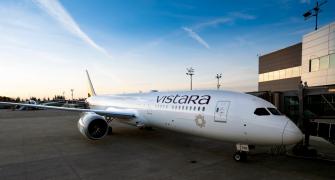The Union government’s food subsidy programme has helped blunt the impact of the Covid crises on the poor and also eased the poverty rate since its introduction in 2013, barring the pandemic-affected 2020-21, according to a working paper of the International Monetary Fund (IMF).

The paper — titled ‘Pandemic, Poverty, and Inequality: Evidence from India’ — disputed an earlier study by Pew Research Centre that claimed 75 million people were pushed into poverty in 2020 because of Covid-led disruptions.
It said the Pew study was based on the outdated methodology of uniform reference period (URP).
One of the authors of the IMF study —former chief economic advisor Arvind Virmani — said 15-25 million Indians were pushed into poverty during 2020-21 but the impact of that was offset by the free distribution of food items to 800 million people.
He further said India has "eliminated low-income poverty (which is based the purchasing power parity or PPP of $1.9 per person a day)".
According to the study, the rate of extreme poverty in India, which means those earning less than $1.9 per day on the PPP basis, was 4.1 per cent during 2020-21, against 2.2 per cent during the previous year, if food transfers by the government aren’t taken into account.
The PPP value of a dollar is different from the market value.
A dollar in PPP terms is currently valued at Rs 20.65, against Rs 15.55 in 2011.
If food transfers are taken into consideration, extreme poverty rose a bit to 1.42 per cent in 2020-21, from 1.3 per cent a year ago.
The IMF has clarified that the views expressed in the paper are of the authors -- Surjit Bhalla, executive director for India at the Fund, Virmani, and Karan Bhasin, a policy researcher -- and do not necessarily represent those of the multilateral agency.
The poverty rate, which means those earning less than $3.2 a day on the PPP basis, rose to 31 per cent in 2020-21, from 23.3 per cent in 2019-20, if food transfers aren’t taken into account.
If those are accounted for, the poverty rate increased to 22.8 per cent in 2020-21, from 19 per cent a year ago.
The working paper used the consumer expenditure survey by the National Statistical Office (NSO) for its calculations.
But the last such survey came in 2011-12.
The latest survey of 2017-18 was junked by the government.
The authors used the real gross state domestic product (GSDP) growth rate to arrive at the poverty figures.
Alternatively, the authors used the data on real private final consumption expenditure growth to reach at poverty estimates beyond 2011-12.
Using this methodology, it found that extreme poverty rose to 2.5 per cent during the Covid-affected 2020-21 from 1.4 per cent in the previous year if food transfers aren’t taken into account.
If those are taken into account, extreme poverty rose to just 0.86 per cent from 0.76 per cent over this period.
Poverty at less than $3.2 a day on the PPP basis rose to 26.5 per cent from 18.5 per cent over the period if food transfers aren’t factored in.
If food transfers are taken into account, it rose to 18.1 per cent from 14.8 per cent.
However, Virmani said the poverty estimates based on the methodology using real GSDP growth are relatively accurate.
The study is in sharp contrast to the one conducted by Pew Research Centre which was based on the URP method – that the IMF working paper dubbed “outdated”.
In the URP method, people are asked about their consumption expenditure over the past month alone.
This method was discarded in India in 1999-2000. From then until 2011-12, India used a mixed reference period (MRP).
Under this, the data about less-frequently used items -- health, education, clothing, durables -- are collected over a one-year period, while sticking to the 30-day recall for the rest of the items.
The World Bank uses the modified mixed reference period (MMRP).
Under this, for certain food items, instead of a 30-day recall, data on only a 7-day recall is collected.
Also, for some low-frequency items, instead of a 30-day recall, information about one-year recall is collected.
The IMF study used the MMRP method.
The study defended its exercise of factoring in food subsidy for poverty estimation.
"The estimate solely on the basis of reported consumption expenditures will lead to an overestimation of poverty levels.
"Incorporation of the subsidy data allows us to conclude that pandemic support measures instituted by the government were critical in preventing any increase in the prevalence of extreme poverty," it said.
The authors noted that food subsidies have reduced poverty on a consistent basis since the enactment of the National Food Security Act, 2013, and the co-incidental increase in the efficiency of targeting via the use of Aadhaar.
The study said the low level of extreme poverty suggests that the official poverty line should now be $3.2 on the PPP basis.
India has not come out with a new poverty line since the formation of the Narendra Modi-led government at the Centre.
Earlier, the erstwhile Planning Commission used to measure the number of poor on the basis of the poverty line.
According to one such report, 21.9 per cent of the population was poor in India in 2011-12, against 29.8 per cent in 2009-10.
That report was based on the Suresh Tendulkar methodology.
By that, those who spent more than Rs 33 a day in urban areas and Rs 27 in rural areas were not treated as poor, triggering a controversy.
Ultimately, the C Rangarajan-led panel came up with another report that said the number of the poor in India was much higher in 2011-12 at 29.5 per cent.
That report took a person spending less than Rs 47 a day in cities and those spending less than Rs 32 a day in villages as poor.
This poverty line approach was abandoned by the NITI Aayog, which replaced the Planning Commission on January 1, 2015.










